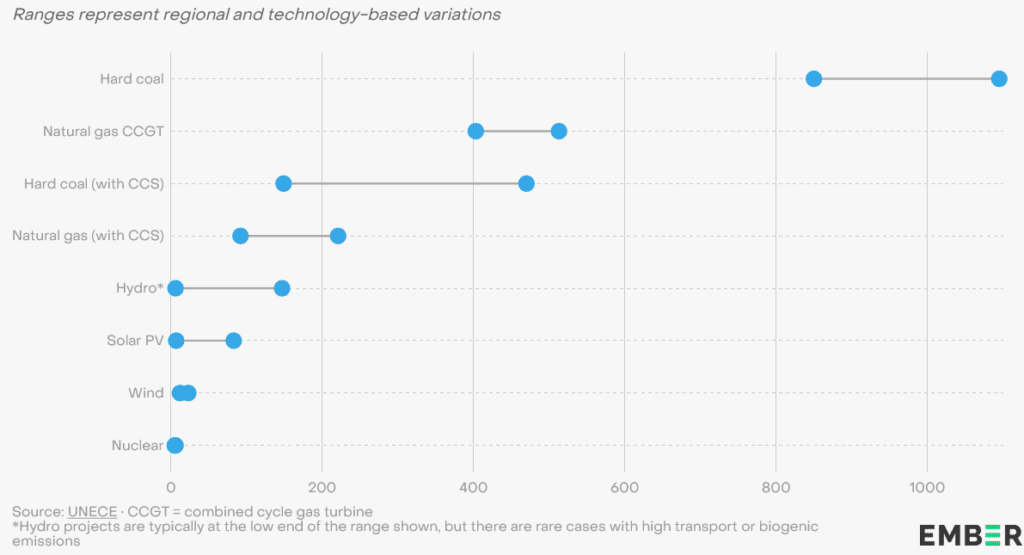Carbon Capture vs Renewable Energy
22 April 2024 – by Viktor Tachev
While there is growing momentum behind carbon capture and storage (CCS) deployment, experts advise that its role in the energy transition should be limited to decarbonising hard-to-abate industries. Any potential application at power plants as a means to complement or replace renewables would prove costly and inefficient. Furthermore, the associated health and environmental controversies, coupled with the fact that most of the captured CO2 is reused for fossil fuel exploration, undermine the reasoning behind CCS investments as a means for decarbonisation.
Asia’s Plans For Carbon Capture and Storage Investments (CCS)
China leads CCUS project development in Asia, with nearly 100 projects in operation or under construction. Indonesia and Malaysia seek to build capacity for capturing and storing carbon in depleted oil and gas reservoirs. The two countries intend to serve as regional storage hubs for neighbouring countries.

Furthermore, the group of 10 Southeast Asian countries is exploring cross-border carbon transport and storage.
According to McKinsey, the APAC region can account for 55% of the global CCUS capacity by 2050. Wood MacKenzie projects Asia’s cumulative CCUS capacity to reach above 90 million tonnes by 2030. For reference, current global CCUS capacity is around 63 million.

The promotion of CCS technology across Asia is led by organisations and initiatives like the Asia CCUS Network, the Global CCS Institute and its South East Asia CCS Accelerator program, the Society of Petroleum Engineers, and more.
While the Global CCS Institute states that “the greatest need for CCS exists in hard-to-abate sectors,” some countries and companies are actively pushing for the technology’s widespread adoption in the energy sector.
Economics Don’t Favour Carbon Capture Technologies
While over 500 projects are in the pipeline, only around 40 commercial CCS sites operate globally today. Moreover, several high-profile projects have been abandoned or shuttered due to uncertain economics and technological complexity.
CCUS costs can vary based on various factors, including the concentration of CO2, type of technology, system complexity, industry and more. Yet, for the most part, they have remained consistently high. The cost reductions have been slow, despite the technology being in use commercially for over 50 years.
According to Oxford scientists, CCS is expensive. They conclude that its decarbonisation ability is more inefficient than that of renewables and efficiency. The research also notes that heavy dependence on CCS to reach net-zero targets around 2050 would be “highly economically damaging”. The total costs are around USD 30 trillion more than a route based primarily on renewable energy, energy efficiency, and electrification.
Furthermore, the phase-out of fossil fuel plants with CCS in the upcoming years risks making new CCS infrastructure stranded.
Additionally, each CCUS system has high upfront costs, often upwards of USD 1 billion. The revenue structure is also riskier than that of renewables.
A recent report by the IEEFA found that CCS paired with fossil fuels will significantly increase energy prices and surface various associated environmental issues. The International Panel on Climate Change (IPCC) ranks fossil fuel CCS as the least preferable decarbonisation option, with both wind and solar as better alternatives. It also adds that CCS adoption in the energy sector “increases the cost of electricity”.
Even fossil fuel industry officials are acknowledging the high costs of CCS. The Asia Natural Gas & Energy Association notes that it would take mass deployment and incentives, similar to solar and wind, for its costs to potentially drop and make it “highly scalable”.
Exxon, which widely ignores solar and wind in its decarbonisation strategy and already has deals for developing CCS projects in Malaysia and Indonesia, even said that financially supporting CCS projects can become “quite taxing and burdensome” for developing economies.
Efficiency Challenges and Use For Fossil Fuel Exploration
CCS has existed since the 1970s, yet it still faces efficiency challenges. While most projects claim to remove 85-95% of carbon emissions, Stanford scientists estimate that the actual efficiency can be as low as 10-11%. According to the Center for International Environmental Law, the figure is lower, 7%. Over a period of 100 years, CCUS plants capture only 20-31% of the CO2.

Today, the existing CCUS infrastructure captures just around 0.1% of emissions. If all projects in development were complete, the total CCUS capacity would capture just 0.7% of today’s emissions. Even at an 18% compound industry annual growth rate, as estimated by Bloomberg NEF, by 2035, CCS would capture just 1.1% of annual emissions.
Furthermore, according to separate studies by the IEEFA and the Washington Post, most of the CO2 captured to date has been used for additional fossil fuel extraction.

The limited efficiency and the fact that captured CO2 is often reused for fossil fuel exploration make the argument that CCUS systems may actually increase emissions.
However, Exxon recently announced that its investments in CCS projects in Malaysia and Indonesia don’t target enhanced oil recovery, since the process “doesn’t quite work commercially nor does it work technically”.
Project Complexity
McKinsey identifies various challenges for CCUS’ development in Asian countries, except China. According to the analysts, most markets have a low Global CCS Institute readiness index score.
Furthermore, CCUS systems can’t be mass-produced, since they are specifically designed to match each facility. They are also complex to coordinate because often, a different company owns and operates each step of the process — capture, transport and sequestration.
Health and Environmental Concerns
In the US and Canada, the current hot spots for CCS development, a group of over 500 organisations have already launched a campaign. They have requested that policymakers scrap projects due to economic, environmental and health concerns.
According to estimates, in the case of mass CCS adoption, even a 0.1% leakage rate could cause up to 25 gigatonnes of additional CO₂ emissions released in the 21st century. This is equal to India’s CO2 emissions for 9 years. However, CO2 isn’t the only harmful gas that can escape in a leak. CCS sites can also emit methane, NOx, PM 2.5 and SO2. All of them pose a threat to the environment. Moreover, each stage of CCS technology requires its own energy source, generating additional CO2 and other co-pollutants. The process also requires significant amounts of water and increases water pollution.
According to the Oakland Institute, CCS poses public health risks. Their types and magnitude depend on the stage of the CCS process.
Furthermore, as a technology, CCS doesn’t capture other potentially damaging air pollutants and toxins from fossil fuel plants, including NOx, SO2, mercury, PM2.5 and more. The health risks associated with them include airway inflammation, cardiovascular disease, cognitive decline, cancer, premature death and more.
CCS vs Renewables: What is the Optimal Decarbonisation Technology Mix?
In a presentation examining the development of CCS in Asia, presented at the Second Asia CCS Network meeting, the authors stated that there was “scientific consensus that CCS is necessary to achieve our climate goals” and that “three of four IPCC illustrative pathways require CCS”. Furthermore, they highlight that the IEA noted that “up to 15% of global emissions could be abated through CCS”.
While all those statements are accurate, they need further contextualising.
First, according to Oxford scientists, CCS can’t deliver the scale of cuts in fossil emissions that renewables and efficiency can. Furthermore, Stanford scientists said that the social cost, including equipment, health and climate costs, of using carbon capture at a coal plant is higher than simply not using it. Alternatively, the technology does more harm than good.
Next, the IPCC notes that CCS has the highest cost and lowest possible contribution to net emissions reduction in energy and industry sectors. Furthermore, the world’s top climate scientists have warned that the implementation of CCS currently faces technological, economic, institutional, ecological, environmental and sociocultural barriers.
The suggestion that CCS can abate up to 15% of global emissions is as per the IEA’s Sustainable Development Scenario. However, the pathway targets net zero by 2070. In this Net Zero Scenario, the role of CCS for power generation is significantly limited.
Renewables Should be the Focus
According to Ember, wind and solar are the cheapest, quickest solutions to deploy and are among the cleanest, least carbon-intensive power sources.
Without existing wind and solar power, power sector emissions would have been 20% higher in 2022. Ember notes a coal plant producing the same amount of energy as a 3 MW wind turbine over 25 years would result in 400,000 tonnes of CO2 emissions. This equals driving an average petrol car around the equator 50,000 times.
Tripling renewables is the leading measure to cut emissions by 2030 and keep the 1.5°C goal alive, notes the IEA. Alongside doubling energy efficiency improvements, it can potentially deliver two-thirds of the total emissions reductions needed by the decade’s end.
According to Ember, tripling wind and solar generation and doubling energy efficiency savings would ensure 85% of the reductions in fossil fuel use needed by 2030 to meet global climate goals.
The environmental gains from renewables are also backed by strong economic reasoning. Between 2010 and 2020, the cost of wind and solar power fell by 55% and 85%, respectively. The cost of batteries used to store renewable electricity also fell by 85% over the same period.
The levelised cost of energy (LCOE) for electricity from renewables also dropped dramatically. In many countries, the electricity production costs for onshore wind and solar PV are lower than gas and coal, often by a significant margin. China, for example, has already reduced the cost of solar power to under USD 0.014 per kWh.

According to IRENA, 85% of new global utility-scale wind and solar capacity was cheaper than fossil fuel alternatives in 2022. Furthermore, building and running new wind or solar farms is already proving cheaper than running existing fossil fuel plants.
Renewable energy deployment since 2000 has helped Asia generate over USD 199 billion in fossil fuel cost savings in 2022.
Carbon Capture Has a Future, But Not at the Expense of Renewables
The IEA, IPCC, and the academies of the G7 have repeatedly called for the retirement of fossil fuel infrastructure. However, adopting technologies like CCS at scale would only perpetuate its use.
Spending trillions on an inefficient, commercially complex and potentially harmful technology to capture CO2 emissions is a self-destructive strategy. There is a cleaner, cheaper and quicker-to-deploy alternative.
Leading scientists and market experts agree that CCS can play a role in decarbonising hard-to-abate sectors, but it shouldn’t extend the life of fossil fuel infrastructure. Pursuing a renewables-led pathway for reducing CO2 emissions from the energy sector is where all efforts should be focused.
by Viktor Tachev
Viktor has years of experience in financial markets and energy finance, working as a marketing consultant and content creator for leading institutions, NGOs, and tech startups. He is a regular contributor to knowledge hubs and magazines, tackling the latest trends in sustainability and green energy.
Read more






